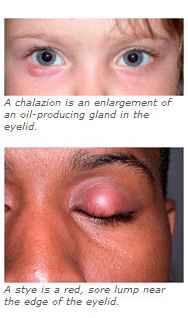Styes and chalazia are small lumps that can arise in or along the eyelid. Often bothersome and sometimes painful, styes and chalazia1 are generally not considered serious eye conditions. Although chalazia and styes appear similar, they have some characteristics that make them medically distinct.

Both styes and chalazia can be caused by blepharitis–a chronic inflammation of the upper and lower eyelids–or another generalized swelling condition. However, the way in which they form differs; they also tend to be situated on different areas of the eyelid.
The term stye is often used to describe any localized swelling of the eyelid. However, the more specific medical term for a stye is hordeolum, which refers to an inflammation and/or infection of the eyelash follicles or the oil glands (meibomian glands).
The term chalazion is derived from a Greek word meaning "small lump." Also called meibomian cysts, chalazia develop when an oil-producing gland–located in the upper and lower eyelids–becomes clogged.
Anyone can develop a stye or chalazion3. If you have a history of blepharitis, you may be more susceptible to the formation of styes or chalazia.
Styes, and chalazia in particular, often resolve themselves. However, if a bacterial infection spreads to surrounding eye tissues, it can lead to an inflammation called preseptal cellulitis. If this occurs, antibiotic treatment will be necessary to control the infection.
A Beach Eye Medical Group in Huntington Beach, Orange County our ophthalmologist can clinically diagnose a stye or chalazion by carefully examining your eyelid. If a stye or chalazion has recurred in the same place, our ophthalmologist may suggest a biopsy to rule out more serious problems. A biopsy involves the surgical removal of small tissue sample so it can be examined by a pathologist.
Styes and chalazia and usually respond well to treatment. A stye or chalazion can be treated with one or a combination of the following:
If you have a stye or chalazion that is exceptionally painful or needs to be drained, contact doctors at Beach Eye Medical Group in Huntington Beach, Orange County to schedule an examination.
References
1 What Is a Stye? Available: https://www.webmd.com/eye-health/styes-causes-symptoms-treatment-prevention
2 Interventions for acute internal hordeolum. Available: https://www.ncbi.nlm.nih.gov/pmc/articles/PMC3424070/
3 What Are Chalazia and Styes? Available: https://www.aao.org/eye-health/diseases/what-are-chalazia-styes
Both the Huntington Beach and Irvine locations were great. I was so very thankful that the staff was able to get me in quickly to be sure shingles hadn't spread completely into my eye. Dr. Shah and Dr. Jwo were awesome. I highly recommend for all of your opthalmological needs.